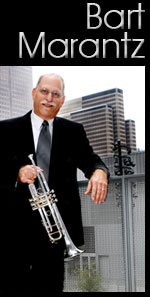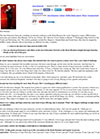 Home B.M.P. BTWHSPVA Articles Interviews Reviews Books Biography Videos Photos Calendar Music Links Contact Sara Marantz Matt Marantz Luke Marantz
Bart Marantz NPR/KERA Jazz Education Interview    Click below to listen to the interview  Click below to read the article 
|
Reviews "Radio Active“ By: Les Sabina Instrumentation: Big Band featuring Vocal Publisher: Kendor Music, Inc. ( From the Konvertibles Series - fit full groups to nine ) Grade: 3 1/2 Funk = 88 $38.00 Radio Active is an original funk chart that is well-written and fun to play. Les Sabina is now teaching at St. Bonaventure University in upstate new York and has performed with “Dizzy” and Joe Williams, to name a few. His experience as a musician and educator is evident in his writing and gives him the base to create some very solid figures for your middle school, high school and college groups. To ensure rhythmic accuracy throughout this piece, it is essential that all the musicians be aware of the 16th-note subdivision known as duple meter. The primary and secondary melodies, saxophone backgrounds, shout section, and bass part all contain 16th notes at some point, but don’t let this scare your musicians away from this chart. Make sure your drummer is emphasizing a 16th-note time-keeper pattern, which will help lock in the duple meter feel and enable everyone to “hear” the subdivision. Try to see that the quarter notes on beats two and four are not accidentally anticipated. Check points for this are measures 3 for piano and 15 for brass. Attention to playing the quarter notes at their full value will help in avoiding the rhythmic difficulties. For soloists, a G concert minor pentatonic scale can be used over many of the provided changes making the task of soloing fun instead of a drudgery. The more experienced soloist can try to alternate between the D concert and G concert Dorian modes at measure 49. To make the notes into music be sure to use the suggested dynamics provided by Les. The loudest level written is ff, and dose not come into play until the very last measure of the chart. Just because it’s a “funk” chart dose not mean that dynamics are not to be observed. A chart like “Radio Active” will be all the more exciting if the level of dynamics are followed exactly as written. Top note for trumpet is written E in the staff. Bart Marantz |


